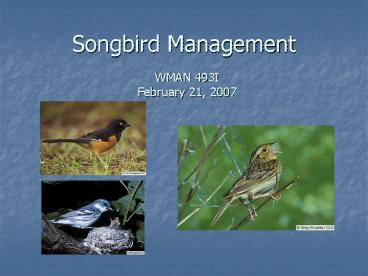Songbird Management - PowerPoint PPT Presentation
1 / 31
Title:
Songbird Management
Description:
Great Crested Flycatcher (Myiarchus crinitus) Kentucky Warbler (Oporornis formosus) ... Acadian Flycatcher (Empidonax virescens) Louisiana Waterthrush. Prefers ... – PowerPoint PPT presentation
Number of Views:33
Avg rating:3.0/5.0
Title: Songbird Management
1
Songbird Management
WMAN 493I February 21, 2007
2
Why Manage for Songbirds?
- Continental Declines
- Greatest Declines in Prairie Regions
- Regional Declines
- 70 of those declining are grassland species
- 41 species are increasing
3
Causes of Songbird Decline
- Potential Causes
- Habitat Loss, Degradation, or Fragmentation
- Breeding Grounds
- Migratory Routes
- Wintering Grounds
- Reproductive Issues
4
(No Transcript)
5
Habitat Loss
- Conversion of early-successional landscape to
mature forest - Urban and Recreational Development
- Mining
- Forest Health Management
- Invasive Plant Species
- Habitat loss in wintering grounds
6
(No Transcript)
7
Habitat Fragmentation
- Creates edge effects
- Increases susceptibility to Opportunists
- Limits opportunities Area-sensitive species
8
Reproductive Issues
- Brood Parasitism
- Nest Predation
- Hybridization
9
Habitat Suites
- Often conflicting priorities between Early and
Late-successional habitats and species - What is the true baseline for historical presence
and importance - Management different in each suite
10
Mature Deciduous Forest
11
Habitat Use
- Species use different components of a forest
landscape - Successional Stage (mid-late)
- Elevation
- Canopy
- Shrub
- Ground
- Snags
12
(No Transcript)
13
Species of Interest/Concern
- Cerulean Warbler (Dendroica cerulea)
- Great Crested Flycatcher (Myiarchus crinitus)
- Kentucky Warbler (Oporornis formosus)
- Worm-Eating Warbler (Helmitheros vermivorum)
14
Cerulean Warbler
- Declining over breeding range
- Habitat Requirements
- Tall complex canopy
- Large tracts of land
15
Songbird Management in Deciduous Forests
- Should address microhabitat needs
- Maintain a balance of forest-age structures
- Ensure long-term tree-species composition
- Maintain structural diversity
- Minimize levels of fragmentation
16
Riparian/Bottomland Forest
17
(No Transcript)
18
Species of Interest/Concern
- Cerulean Warbler (Dendroica cerulea)
- Louisiana Waterthrush (Seiurus motacilla)
- Acadian Flycatcher (Empidonax virescens)
19
Louisiana Waterthrush
- Prefers large tracts (gt100 ha)
- Requires clean, rapidly flowing water
- Rare in fragmented areas or those with poor water
quality
20
Songbird Management in Riparian Forests
- Minimize timber activity near forested riparian
areas - Maintain wide riparian forest corridors
(preferably 100 meters)
21
Shrub - Early Successional
22
(No Transcript)
23
Species of Interest/Concern
- Appalachian Bewicks Wren (Thryomanes bewickii)
- Golden-Winged Warbler (Vermivora chrysoptera
24
Golden-Winged Warbler
- Declining 10.8/yr
- Prefers dense patches of herbs/shrubs with few
trees - Favor mid-size (10-15 ha) patches
- Susceptible to hybridization nest
parasitism/predation
25
Songbird Management in Early-Successional
Landscapes
- Primary Goal Maintain areas in
early-successional stage - Possible cooperators
- Power Companies
- Mining Companies
- Promote value of shrub/scrub habitat to the public
26
Grasslands
27
(No Transcript)
28
Species of Interest/Concern
- Henslows Sparrow (Ammodramus henslowii)
- Loggerhead Shrike (Lanius ludovicianus)
- Dickcissel (Spiza americana)
29
Henslows Sparrow
- Continentally Very Rare
- Regionally Strong
- Prefers tall unmowed hayfields reclaimed
surface mines
30
Songbird Management in Grasslands
- Enhance existing agricultural and reclaimed mine
sites - Consolidation of adjacent fields
- Prescribed fire to control woody growth
- Mowing
31
Songbird Management Monitoring Programs
- Partners in Flight (PIF)
- North American Breeding Bird Survey (BBS)
- Audubon Christmas Bird Count
- WatchList
- Project Feeder Watch































